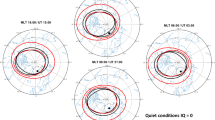Abstract
KENT1 has reported a series of observations on the 40 Mc./s. transmissions from Sputnik 1 made at Cambridge during October 1957. He found that the transmissions always underwent rapid fading (scintillation) when the satellite was north of Cambridge but only occasionally when south of Cambridge. He concluded that the scintillations were due to ionospheric irregularities which are north of the observing station but not south of it. Further, since the southward extent of the scintillation region was greater for satellite passes to the west of Cambridge than to the east, he postulated that the density of the irregularities is controlled by the magnetic rather than geographic latitude (Cambridge's declination is about − 9°). Mawdsley2 objected to Kent's seemingly arbitrary assumption that the irregularities do not occur south of the observer, on the grounds that radio star scintillations are observed at lower latitudes than that of Cambridge. He suggested an alternative interpretation of Kent's results in terms of preferential forward scattering by the irregularities, assumed to be field aligned, when the line of sight from the observer to the source is normal to the field lines. Afterwards, Bain3 and Frihagen and Tröin4, working at Slough and Kjeller respectively, observed scintillations when the satellite under observation was south of the observing station. However, they both found that the scintillation activity increased for geomagnetic latitudes greater than that of Cambridge, that is, 55°. This led Frihagen and Tröin to support Kent's interpretation. It is the purpose of this communication to point out the existence of further pieces of evidence which support Kent's point of view rather than Mawdsley's.
This is a preview of subscription content, access via your institution
Access options
Subscribe to this journal
Receive 51 print issues and online access
$199.00 per year
only $3.90 per issue
Buy this article
- Purchase on Springer Link
- Instant access to full article PDF
Prices may be subject to local taxes which are calculated during checkout
Similar content being viewed by others
References
Kent, G. S., J. Atmos. Terr. Phys., 16, 10 (1959).
Mawdsley, J., J. Atmos. Terr. Phys., 18, 344 (1960).
Bain, W. C., Nature, 189, 129 (1961).
Frihagen, J., and Tröin, J., J. Atmos. Terr. Phys., 20, 215 (1961).
Booker, H. G., Proc. Inst. Radio Eng., 46, 6363 (1958).
Yeh, K. C., and Swenson, G. W., J. Geophys. Res., 64, 2281 (1959).
de Mendonca, F., Villard, O. G., and Garriot, O. K., Proc. Inst. Radio Eng., 48, 2028 (1960).
Singleton, D. G., J. Geophys. Res., 65, 3615 (1960).
Koster, J. R., J. Atmos. Terr. Phys., 12, 100 (1958).
Hewish, A., Proc. Roy. Soc., A, 214, 494 (1952).
Little, C. G., and Maxwell, A., Phil. Mag., 42, 267 (1951).
Bolton, J. G., Slee, O. B., and Stanley, G. G., Austral. J. Phys., 6, 434 (1958).
Singleton, D. G., Lynch, G. J. E., and Thomas, J. A., Nature, 189, 30 (1961).
Author information
Authors and Affiliations
Rights and permissions
About this article
Cite this article
SINGLETON, D. Scintillations and the Latitude Distribution of Ionospheric Irregularities. Nature 191, 482–483 (1961). https://doi.org/10.1038/191482c0
Published:
Issue Date:
DOI: https://doi.org/10.1038/191482c0
Comments
By submitting a comment you agree to abide by our Terms and Community Guidelines. If you find something abusive or that does not comply with our terms or guidelines please flag it as inappropriate.



